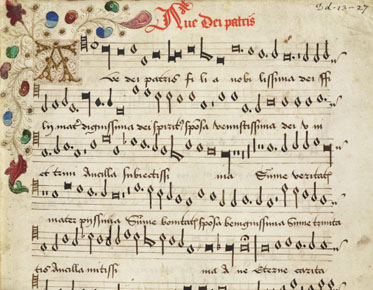|
Choirbooks, partbooks and scores
 |
| The ornamental capital for the opening of Ave Dei patris filia, c. 1525. MS.Dd.13.27 |
The earliest polyphony (music in which several voices sing different melodies at the same time) was copied into choirbooks, with each voice part written separately onto a different section of a single opening around which all the singers would gather. Some of these books were of considerable size, and one of the few surviving examples in Cambridge is on display. By the beginning of the sixteenth century the practice of copying each part into a separate book was developed, with each singer using a small volume containing only their own notes.
The copying of music into full score became common only in the early seventeenth century. The disestablishment of the church and destruction of so much cathedral music during Cromwell’s Commonwealth meant that after the Restoration in 1660 much had to be done to recover the music. The shock of that loss led to the birth of musical antiquarianism and the establishment of the first serious libraries of ‘old’ music. Important collectors included James Hawkins of Ely, whose collection is now part of the Ely Cathedral choir manuscripts deposited in the University Library. |
